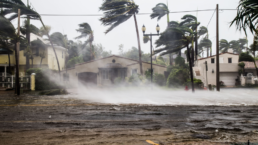Florida politicians would rather keep taxes on the wealthy low than average families safe.
By Sam Pizzigati, Inequality.org
Last month’s Hurricane Ian has already faded from the headlines, but local officials and insurers are still tallying up the total damage. The storm may well end up America’s second-costliest hurricane ever.

Florida’s total damage bill, the global property analyst CoreLogic now estimates, could hit $70 billion. The good news? Without the federal program that discourages development in Florida’s flood-prone inland area south of Tampa, CoreLogic’s Tom Larsen points out, Hurricane Ian’s toll would be running far higher.
Florida’s coasts — by far the state’s most vulnerable real estate — have no comparable federal protection. On these coasts, Florida’s state government calls the shots. Actually, we need to get a bit more precise here. Florida’s state government doesn’t call the shots. Florida’s rich do, and the continuing immensity of their after-tax incomes has turned out to matter far more to state policy than the well-being of Floridian families of modest means.
How so? Let’s start with CoreLogic’s analysis of Hurricane Ian’s damage. The “key reason” why Hurricane Ian has been “so economically destructive,” notes CoreLogic’s Larsen, has been Florida’s “massive growth in coastal real estate.” That coastal growth has accounted for a disproportionate share of Florida’s 50-percent population jump since 1992, the year “when Hurricane Andrew hit Miami.”
Recent Posts
Stop Israel’s Dystopian “Humanitarian City” Plan—Before It’s Too Late
July 11, 2025
Take Action Now For the past 20 months, the world has watched—and largely enabled—a genocidal campaign in Gaza. Over 55,000 Palestinians have been…
The “Liberal” International Order Is Criminalizing Palestine Protests
July 11, 2025
Take Action Now As Western governments repress Palestine solidarity and enable Israel’s impunity, the “liberal international order” is no longer…
Politicians Are Betraying Gen Z On Climate
July 10, 2025
Take Action Now While Gen-Zers thrift, knit, crochet, and find other ways to reduce our footprints, Trump and the GOP are greenlighting more climate…
Trump’s Deportation Threat Against Zohran Mamdani Is Shameful
July 10, 2025
Take Action Now In only half a year of Donald Trump’s presidency, he and his allies have turned deportation into an explicitly political threat…




